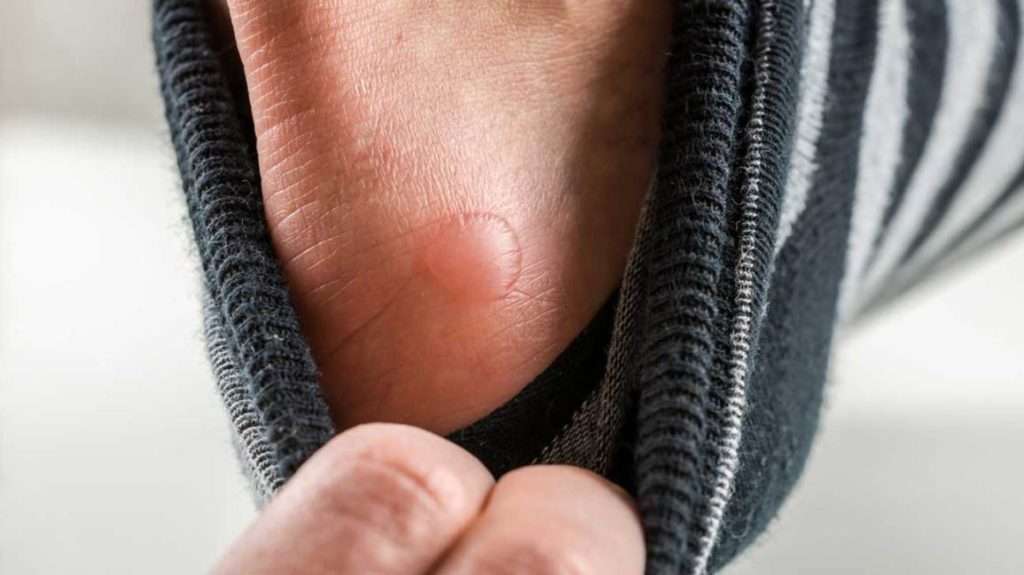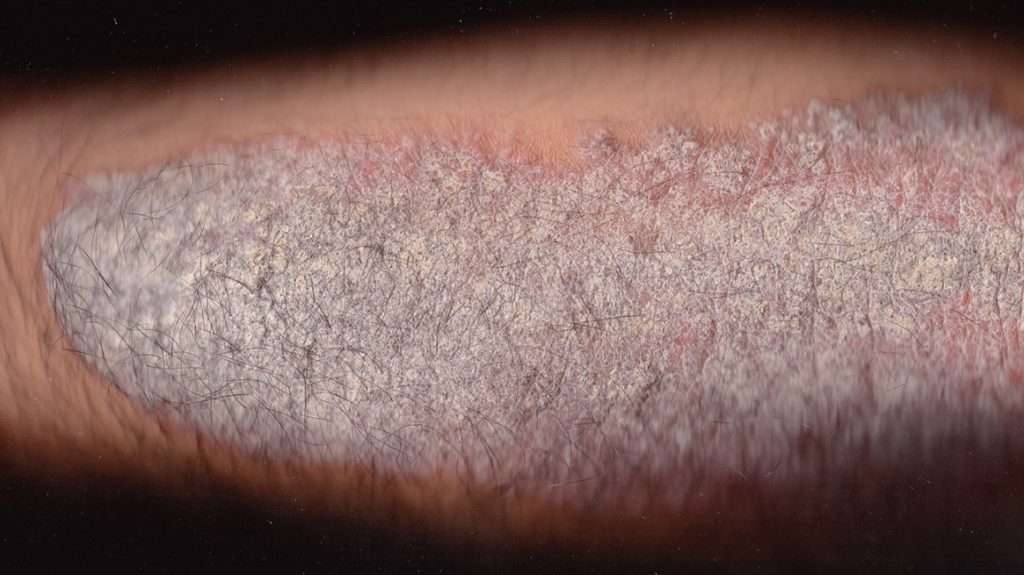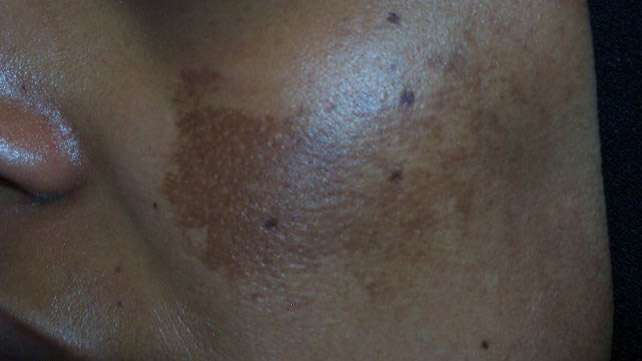Common Skin Disorders

Acne
- Commonly located on the face, neck, shoulders, chest, and upper back
- Breakouts on the skin composed of blackheads, whiteheads, pimples, or deep, painful cysts and nodules
- May leave scars or darken the skin if untreated

Cold sore
- Red, painful, fluid-filled blister that appears near the mouth and lips
- Affected area will often tingle or burn before the sore is visible
- Outbreaks may also be accompanied by mild, flu-like symptoms such as low fever, body aches, and swollen lymph nodes

Blister
- Characterized by watery, clear, fluid-filled area on the skin
- May be smaller than 1 cm (vesicle) or larger than 1 cm (bulla) and occur alone or in groups
- Can be found anywhere on the body

Hives
- Itchy, raised welts that occur after exposure to an allergen
- Red, warm, and mildly painful to the touch
- Can be small, round, and ring-shaped or large and randomly shaped

Actinic keratosis
- Typically less than 2 cm, or about the size of a pencil eraser
- Thick, scaly, or crusty skin patch
- Appears on parts of the body that receive a lot of sun exposure (hands, arms, face, scalp, and neck)
- Usually pink in color but can have a brown, tan, or gray base

Rosacea
- Chronic skin disease that goes through cycles of fading and relapse
- Relapses may be triggered by spicy foods, alcoholic beverages, sunlight, stress, and the intestinal bacteria Helicobacter pylori
- There are four subtypes of rosacea encompassing a wide variety of symptoms
- Common symptoms include facial flushing, raised, red bumps, facial redness, skin dryness, and skin sensitivity

Eczema
- Yellow or white scaly patches that flake off
- Affected areas may be red, itchy, greasy, or oily
- Hair loss may occur in the area with the rash

Psoriasis
- Scaly, silvery, sharply defined skin patches
- Commonly located on the scalp, elbows, knees, and lower back
- May be itchy or asymptomatic

Carbuncle
- Red, painful, and irritated lump under your skin
- May be accompanied by fever, body aches, and fatigue
- Can cause skin crustiness or oozing

Latex allergy
- Rash may occur within minutes to hours after exposure to a latex product
- Warm, itchy, red wheals at the site of contact that may take on a dry, crusted appearance with repeated exposure to latex
- Airborne latex particles may cause cough, runny nose, sneezing, and itchy, watery eyes
- A severe allergy to latex can cause swelling and difficulty breathing

Cellulitis
- Caused by bacteria or fungi entering through a crack or cut in the skin
- Red, painful, swollen skin with or without oozing that spreads quickly
- Hot and tender to the touch
- Fever, chills, and red streaking from the rash might be a sign of serious infection requiring medical attention

Measles
- Symptoms include fever, sore throat, red, watery eyes, loss of appetite, cough, and runny nose
- Red rash spreads from the face down the body three to five days after first symptoms appear
- Tiny red spots with blue-white centers appear inside the mouth

Basal cell carcinoma
- Raised, firm, and pale areas that may resemble a scar
- Dome-like, pink or red, shiny, and pearly areas that may have a sunk-in center, like a crater
- Visible blood vessels on the growth
- Easy bleeding or oozing wound that doesn’t seem to heal, or heals and then reappears

Squamous cell carcinoma
- Often occurs in areas exposed to UV radiation, such as the face, ears, and back of the hands
- Scaly, reddish patch of skin progresses to a raised bump that continues to grow
- Growth that bleeds easily and doesn’t heal, or heals and then reappears

Melanoma
- The most serious form of skin cancer, more common in fair-skinned people
- Mole anywhere on the body that has irregularly shaped edges, asymmetrical shape, and multiple colors
- Mole that has changed color or gotten bigger over time
- Usually larger than a pencil eraser

Lupus
- Symptoms include fatigue, headaches, fever, and swollen or painful joints
- Scaly, disc-shaped rash that doesn’t itch or hurt
- Scaly red patches or ring shapes most commonly located on the shoulders, forearms, neck, and upper torso that worsen with exposure to sunlight
- Warm, red rash that spreads across the cheeks and bridge of the nose like butterfly wings and worsens in the sun

Contact dermatitis
- Appears hours to days after contact with an allergen
- Rash has visible borders and appears where your skin touched the irritating substance
- Skin is itchy, red, scaly, or raw
- Blisters that weep, ooze, or become crusty Read full article on contact dermatitis.

Vitiligo
- Loss of pigment in the skin due to autoimmune destruction of the cells that give skin its color
- Focal pattern: loss of skin color in only a few small areas that may merge together
- Segmental pattern: depigmentation on one side of the body
- Premature graying of scalp and/or facial hair

Wart
- Caused by many different types of a virus called human papillomavirus (HPV)
- May be found on the skin or mucous membranes
- May occur singly or in groups
- Contagious and may be passed to others

Chickenpox
- Clusters of itchy, red, fluid-filled blisters in various stages of healing all over the body
- Rash is accompanied by fever, body aches, sore throat, and loss of appetite
- Remains contagious until all blisters have crusted over

Seborrheic eczema
- Yellow or white scaly patches that flake off
- Affected areas may be red, itchy, greasy, or oily
- Hair loss may occur in the area with the rash

Keratosis pilaris
- Common skin condition most often seen on the arms and legs, but might also occur on the face, buttocks, and trunk
- Often clears up on its own by age 30
- Patches of skin that appear bumpy, slightly red, and feel roug
- May get worse in dry weather

Ringworm
- Circular-shaped scaly rashes with raised border
- Skin in the middle of the ring appears clear and healthy, and the edges of the ring may spread outward
- Itchy

Melasma
- Common skin condition that causes dark patches to appear on the face and, rarely, the neck, chest, or arms
- More common in pregnant women (chloasma) and individuals with darker skin color and heavy sun exposure
- No other symptoms beyond skin discoloration
- May go away on its own within a year or may become permanent

Impetigo
- Common in babies and children
- Rash is often located in the area around the mouth, chin, and nose
- Irritating rash and fluid-filled blisters that pop easily and form a honey-colored crust
